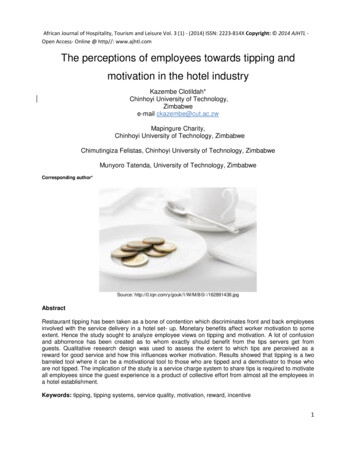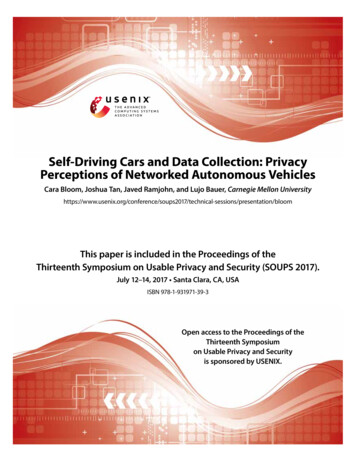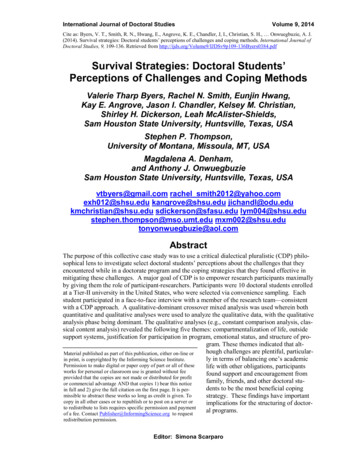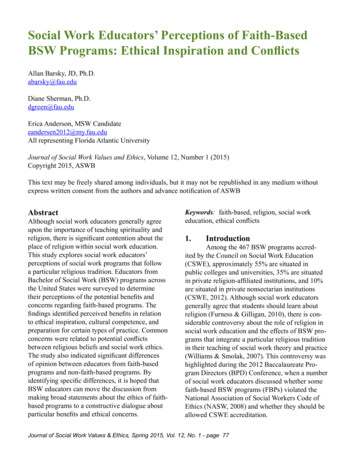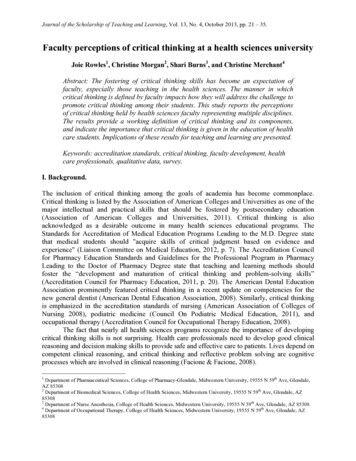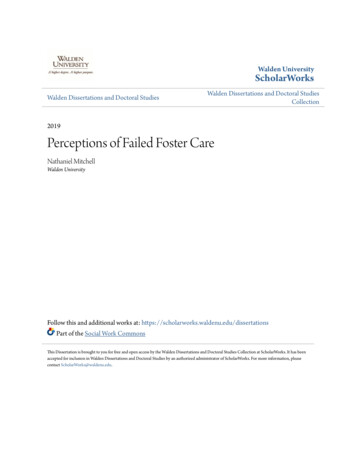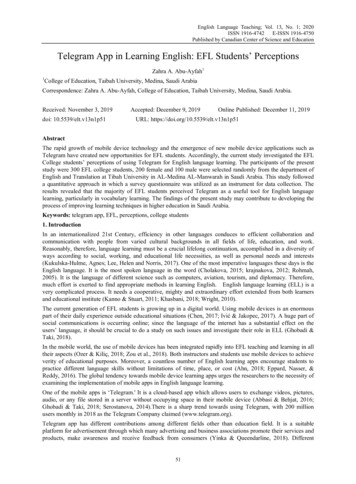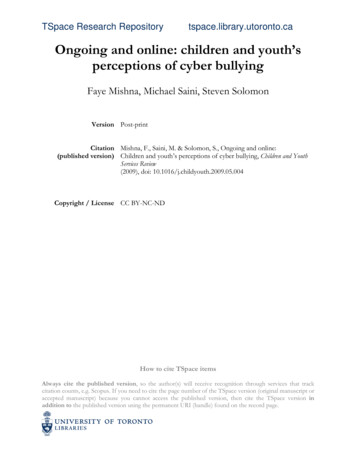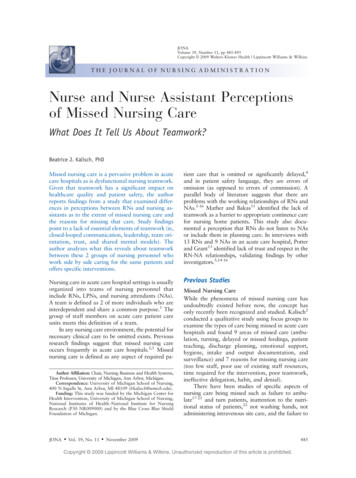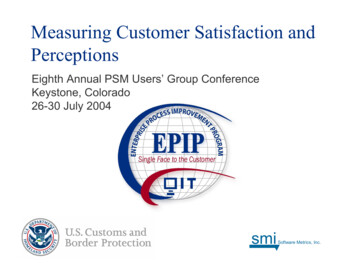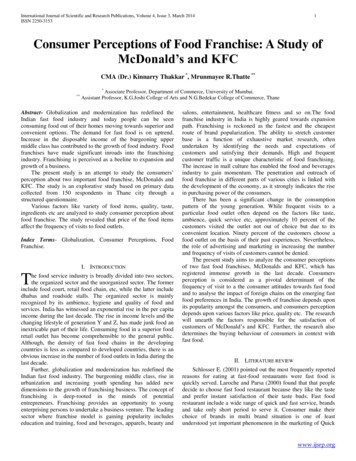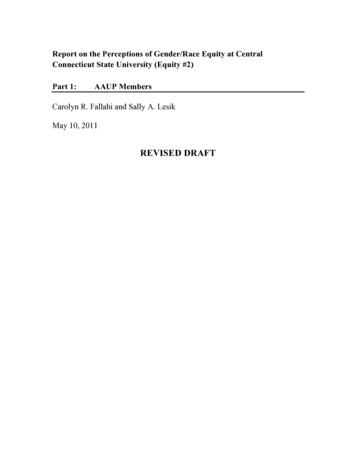
Transcription
Report on the Perceptions of Gender/Race Equity at CentralConnecticut State University (Equity #2)Part 1:AAUP MembersCarolyn R. Fallahi and Sally A. LesikMay 10, 2011REVISED DRAFT
1Table of ContentsSummaryofFindingsonPromotionandTenure tionsatCCSU 7SectionI:IntroductionandBackground .10PreviousresultsoftheEquityOneStudy .10SectionTwo:GoalsoftheCurrentProject .13SpecificStudyGoals 13ResearchTeam .15SectionThree:Procedure .16SurveyonthePerceptionsofEquity . .16Participants .16DataCollectionProcess . .17ContactMethods .18ProblemsEncountered 18SectionFour:Results 21ArchiveDatabase 21PromotionProfiles(teachingfacultyonly) .22PromotionfromAssistanttoAssociateProfessor .23Data .23Whydiscrete- ‐timesurvivalanalysis?.24Analysis .25Results .27PromotionfromAssociatetoFullProfessor . .31
2Results . 33SurveyDatabase 42SamplingPlan y .43DemographicInformation 43TheEffectsofFamily 44CharacteristicsofSpouseorSignificantOther 44FamilyCommitmentsandCareer 48Perceptionsofdiscrimination 50Respect .51Salary .51DepartmentQuestions .54Research/SpecialProjects/ReassignedTime 58GenderConcerns .64RacialConcerns 66Separation 68Recommendations .69References 72
nattimeofhire(instructionalfacultyonly) ttimeofhire(instructionalfacultyonly) ofessor fFullProfessor nfromAssistanttoAssociateProfessor(n 172) onyear 37Table7:Numberofuncensoredandcensoredfull- rmark onfromAssociatetoFullProfessor(n 89) 40Table9:Numberofuncensoredandcensoredfull- ‐timetenuretrackAssociateProfessorsattheeight- ‐yearmark dtheAAUPsurvey rmerandcurrentAAUPmembers otherswork articipantscouldselectmorethanoneresponse) 46
vechildren eycouldcountonpeopleatworkindifficultsituations cancountonpeopleoutsideofworkindifficultsituations career mily nflictsbetweenworkandfamilydemands gisvaluedbytheirdepartment ionofworkintheirdepartmentbasedongender ionofworkintheirdepartmentbasedonrace ionofworkintheirdepartmentbasedonseniority valuedatCCSU ies sparencytothePromotionandTenureProcessatCCSU nessinthePromotionandTenureProcessatCCSU iththepromotionandtenureprocess r- ‐specificbiasesorobstaclestocareersuccess 66
effectsfromracialremarksfromcolleagues iveracialexperiencesaffectedtheircareer itiesformodelequation(2) theproportionofmaleandfemaletenure- orfromtherankofAssistantProfessorinthefirstsix- ‐yearsattheinstitution 38
6Report on the Perceptions of Gender/Race Equity atCentral Connecticut State University (Equity #2)SummaryofFindingsonPromotionandTenureWe examined data on new hires from 1990-2010. We found that at all ranks,more males were hired as compared to females, but especially at the rank of FullProfessor. Further, more males attained the rank of Full Professor as compared tofemales. There were no significant differences in the number of Whites versus Minoritycandidates attaining the rank of Full Professor. A discrete-time survival analysis wasused to examine the time-to-promotion question. There was no main effect of gender orminority indication on whether and when a new, tenure-track faculty hire achieves therank of Associate Professor from the rank of Assistant Professor. Further, minorityindication was not significant and did not vary over time. That was not the case forgender. The effect of gender on promotion did vary across years. Females may takeslightly longer to achieve the promotion to Associate Professor as compared to males asthe median time to promotion for males was approximately 3.5 years as compared tofemales at approximately 4 years. Further, just under 90% of the male and femaleAssistant Professors achieve promotion to Associate Professor within their first six yearsat the institution, but significantly more females achieve the rank of Associate Professorin their sixth year when compared to males. Similar discrete-time survival analyses wereconducted for promotion to Full Professor for those faculty who either were hired as, orwho achieved the rank of Associate Professor. We found that a significantly greaterproportion of females do not achieve promotion to Full Professor at the eight-year mark
7as compared to males, and that older applicants are less likely to achieve promotion toFull Professor as compared to younger faculty.Summary of Findings for the Survey on Faculty’s Perceptions at CCSUDespite an extraordinary effort on the part of the researchers, the response rate forthis survey was 19.3% out of a possible 514 identified AAUP members who met thecriteria for the study. We examined a number of areas that have been identified in theequity literature as being important variables for differences in success at work. Issuesrelated to family have been regularly cited as a factor in the ability to attain tenure andpromotion. Highlights from this survey include the following. Faculty indicateddifficulties with work and family life balance; specifically dealing with children, agingparents, childcare, and time off from work for family issues were particularly stressful.Almost half of the sample indicated that family commitments were impacted by theircareer aspirations; specifically, that faculty members describe challenges in dealing withteaching, publishing, and sacrifices to their family life. Several indicated that theypostponed having children until they had achieved tenure. Many respondents wrote thatthe university needs to be more supportive of family issues.One area of concern that was identified on the survey included salary issues.More than half of the participants were not satisfied with the process of determininghiring salaries at CCSU, given that the initial salary determined their salary trajectorybased on the AAUP contract. Most of the respondents did not feel that they were passedover for promotion or tenure because of race or gender.We also examined the perceptions of the campus climate at CCSU. Most of therespondents felt connected to their department and felt that they could go to their
8department chair with concerns. Slightly over half of the respondents felt that they couldtalk with their Dean if they had an issue. Most of the participants felt that teaching wasvalued in their department, but many indicated that research is being judged viapromotion and tenure as more important. Further, many complained that their teachingload was excessively high and significantly interfered with their ability to produce highquality research. Several faculty complained about the lack of a formal mentoringprogram that is needed in order to be successful at CCSU. While many completing thesurvey felt that there was a fairly equitable division of work in their department, wefound a larger percentage of females serving on department committees as a compared tomales.While over 75% of the respondents felt that they have been treated with respect atCCSU, almost 68% felt that there was a morale problem with approximately 100% ofminority respondents perceiving a morale problem at CCSU as compared to 62.5% ofWhite respondents.Faculty were asked about their perceptions of the Promotion and Tenure processat CCSU and 28% indicated that there was transparency in the process. More femalesindicated a lack of transparency as compared to males. While many of the professors feltthat the process has become more transparent in recent years, several faculty indicatedthat there remains ambiguity with the provost and president’s criteria for promotion andtenure.Over 75% of the faculty felt that CCSU makes a good faith effort to recruit andretain women. Most have not encountered unwanted sexual harassment at work;however, 23% responded that they have experienced sex discrimination at work. This
9was significantly higher for females as compared to males. Faculty wrote that there aredifferential expectations for men and women at CCSU; experiences with sexist remarks;and differential workload based on gender. Over 60% of the minority respondents haveexperienced racial discrimination at work as compared to 7% for Whites. Further, theminority respondents talk about having to deal with racial remarks. Most of therespondents did not view the workload as being significantly different because of racialdifferences. Over 70% of the minority respondents did not think that CCSU makes agood faith effort to recruit and retain people of color.
10Section I: Introduction and BackgroundPrevious results of the Equity One StudyDuring the summer of 2008, President Miller commissioned an internal studyusing available resources to investigate trends and patterns regarding gender and raceequity at Central Connecticut State University (CCSU). Carolyn R. Fallahi and Sally A.Lesik, professors in Psychology and Mathematics, were the principal investigators of thefirst equity study. The findings of this study suggest that at all levels of rank at CCSU,there are significantly fewer numbers of women and minority faculty/SUOAF-AFSCMEemployees. We also found that the salary wage gap for female faculty at CCSU issmaller than is reported by other universities of higher education nationally, though stillsignificant. The estimated wage gap is 97 ½ cents on the dollar. This 2.30% differentialwas the difference in faculty starting salaries when factors such as age rank at hire, andother important variables were included. Once faculty are in the system, salaryadvancement occurs at prescribed increments based on the AAUP contract, thus makingthe initial salary the important variable for any difference. Nonetheless, any difference issignificant for the person experiencing less salary. There were no significant differencesin salary for SUOAF-AFSCME employees based on gender or race.Other findings from the first equity study suggest that CCSU needs to do a betterjob recruiting experienced women and minority faculty/SUOAF-AFSCME employees.There are many minority finalists selected for faculty and SUOAF-AFSCME positions.However, with SUOAF-AFSCME positions, males are being rated as having moreexperience as compared to females and with faculty and SUOAF-AFSCME positions,Whites are being rated as having more experience than minority candidates, and
11ultimately White males seem to get the positions. The university needs to seek outwomen and minority candidates who are equally qualified. Minority candidates are beingidentified in the finalist pool for faculty positions, but there is more of a tendency to hirethe White candidate. In response to some of these concerns, CCSU upgraded theAffirmative Action Officer who is responsible for overseeing that all searches meet theaffirmative action guidelines and comply with existing laws and policies. Finally, theinstitution needs to do a better job of collecting and reporting minority categorization forthe search candidates as much of the data was missing from the available records.The first equity study also examined the number of promotion and tenuredecisions from 2002 through 2008. Although no consistent pattern of discriminationacross these years was found, there were different years in which more men were deniedtenure and promotion than women, more women were denied promotion than men, andmore Minorities were denied promotion as compared to Whites. It was difficult to makeoverall generalizations about the promotion and tenure decisions because the makeup ofthe faculty applying for promotion and/or tenure, and the university promotion and tenurecommittee varies each year. Furthermore, because there have been four different finaldecision makers throughout 2002-2008, it is no surprise that some discrepancies wouldexist.For minority faculty at CCSU, there does not appear to be significant salarydifference when comparing Whites versus Minorities. However, we did not examineindirect measures of inequity that may lead to the perception of discrimination (Bagihole,2002). Skelton (2005) found evidence that universities frequently have inhospitable andhostile environments for women. Krefting (2003) noted that women in academia are
12frequently marginalized. Women report a lack of respect from both students andcolleagues alike more often than do men in academia. Further, they are more likely tocomplain about authority issues, isolation, and difficulties balancing work and family(Krefting, 2003). Probert (2005) found that there is discrimination or bias in theappointments, promotions and workloads of women. They are less likely to have accessto mentoring and other factors that may contribute to their ability to progress in theircareers. Female faculty are 2.5 times more likely to perceive gender discrimination in theacademic environment than were male faculty (Carr, Ash, Friedman, Szalacha, Barnett,Palepu, & Moskowitz, 2000). This discrimination may come in the form of a hostilework environment, sexual harassment, and policies that prevent advancement (Carr et al.,2000). In addition, we did not examine some of the family outcomes that may lead todisparate impacts on the lives of women and men faculty (Perna, 2005).
13Section Two: Goals of The Current ProjectThe goal of the first equity study was to examine direct experiences of gender andracial inequity by way of salary and promotion and tenure. This study did not addressindirect experiences of inequality that may lead to the perception of discrimination northe promotion patterns of faculty. Therefore, the purpose of the second equity study wasto examine the perception of equity at CCSU, and to take a conduct a more detailedanalysis regarding the promotion patterns of AAUP faculty and SUPAF-AFSCMEemployees.Specific Study Goals1) Examine AAUP new faculty who participated in the promotion and tenure experienceover time. Are male and female faculty promoted at the same rate? Are White andMinority faculty promoted at the same rate?2) Examine SUOAF-AFSCME new hires and those considered for a merit-based increaseover time. What factors or variables helped to make them successful with theircontinuing appointment? What factors hindered their success?3) Examine employees, both AAUP and SUOAF-AFSCME, who separated from theuniversity. What were some of the reasons why the separation occurred?4) As this is a study examining perceptions of gender and race equity, the followingtopics were addressed:a. family income levelb. marital statusc. number and age of dependentsd. perceived level of help at home
14e. maternity/paternity time offf. child care arrangements/issuesg. conflicts between work and family demandsh. percentage of time related to household demandsi. receiving help from extended familyj. issues related to elder carek. work issues that arise because of family problemsl. university climate supportive of family issuesm. people inside and outside the university receive support fromn. religious or spiritual affiliationso. career pathp. history of inequity in Ph. D. programq. salary and hiring negotiationsr. promotion and tenure processt. measures of research and teaching expertiseu. welcoming atmosphere in departmentv. credit loadw. number of student’s teach/work withx. teaching scheduley. number of adviseesz. mentoring expectationsaa. advisor expectationsbb. committee expectations
15cc. teaching reduction/reassigned timedd. sabbatical leaveee. office spaceff. research facilitiesgg. perceived sex discrimination/racial discriminationhh. perceived sexual harassmentii. perceived respectjj. atmosphere of the departmentkk. division of work within your departmentll. expectations of workplace atmospheremm. professional advancementResea
One area of concern that was identified on the survey included salary issues. More than half of the participants were not satisfied with the process of determining hiring salaries at CCSU, given that the initial salary determined their salary trajectory based on the AAUP contract. M
